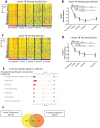Detectable changes in the blood transcriptome are present after two weeks of antituberculosis therapy
- PMID: 23056259
- PMCID: PMC3462772
- DOI: 10.1371/journal.pone.0046191
Detectable changes in the blood transcriptome are present after two weeks of antituberculosis therapy
Abstract
Rationale: Globally there are approximately 9 million new active tuberculosis cases and 1.4 million deaths annually. Effective antituberculosis treatment monitoring is difficult as there are no existing biomarkers of poor adherence or inadequate treatment earlier than 2 months after treatment initiation. Inadequate treatment leads to worsening disease, disease transmission and drug resistance.
Objectives: To determine if blood transcriptional signatures change in response to antituberculosis treatment and could act as early biomarkers of a successful response.
Methods: Blood transcriptional profiles of untreated active tuberculosis patients in South Africa were analysed before, during (2 weeks and 2 months), at the end of (6 months) and after (12 months) antituberculosis treatment, and compared to individuals with latent tuberculosis. An active-tuberculosis transcriptional signature and a specific treatment-response transcriptional signature were derived. The specific treatment response transcriptional signature was tested in two independent cohorts. Two quantitative scoring algorithms were applied to measure the changes in the transcriptional response. The most significantly represented pathways were determined using Ingenuity Pathway Analysis.
Results: An active tuberculosis 664-transcript signature and a treatment specific 320-transcript signature significantly diminished after 2 weeks of treatment in all cohorts, and continued to diminish until 6 months. The transcriptional response to treatment could be individually measured in each patient.
Conclusions: Significant changes in the transcriptional signatures measured by blood tests were readily detectable just 2 weeks after treatment initiation. These findings suggest that blood transcriptional signatures could be used as early surrogate biomarkers of successful treatment response.
Conflict of interest statement
Figures





References
-
- WHO (2010) Global tuberculosis control. World Health Organisation.
-
- CCDC (2007) Center for Communicable Disease Control and Prevention. Reported Tuberculosis in the United States, 2007. C. U.S. Department of Health and Human Services. Atlanta, GA.
Publication types
MeSH terms
Substances
Associated data
- Actions
Grants and funding
LinkOut - more resources
Full Text Sources
Other Literature Sources
Medical
Molecular Biology Databases

